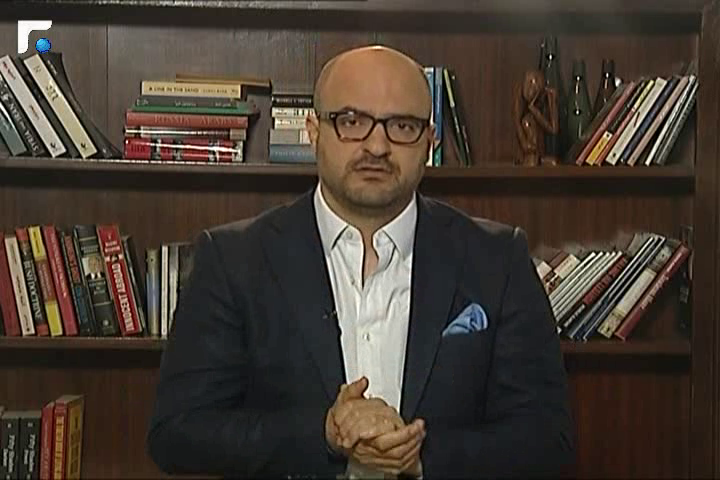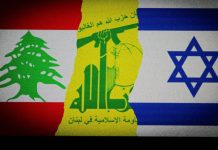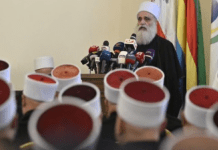شرقان أوسطان يتصارعان
نديم قطيش/الشرق الأوسط/07 حزيران/2022
Two Middle Easts in Conflict
Nadim Koteich/Asharq Al-Awsat/June 07/2022
With the Greek company Energian’s LNG extraction and storage vessel entering the Karish field, going past what Lebanon calls Marine Line 29 and anchoring itself in the zone “disputed” by Israel and Lebanon, the latter has become embroiled in the massive hot struggle to shape the new Middle East.
This development cannot be isolated from an array of others tied to the tug of war between the “two Middle Easts.” One is led by Iran, and another by the moderate Arab states, who are either directly or indirectly allied with Israel, and it comes at a moment when everyone feels that the US retreat from the Middle East demands a new regional security framework that the players of the region will form themselves, depending on their own tools and strengths.
In the Middle East of peace and economy, the announcement of a free trade agreement between the United Arab Emirates and Israel was the first of its kind with an Arab state, which gives us an idea about just how much has changed and continues to change in the region and its relations.
Remarkably, this agreement, which took four rounds of talks between the two countries since last November, unofficially began in Egypt on March 21 and 22, when Israeli President Naftali Bennett met with Emirati President Mohamed bin Zayed Al Nahyan, who was then Crown Prince of Abu Dhabi, and Egyptian President Abdel Fattah al-Sisi. This course makes evident that we are in the midst of a wave of transformations remaking the region that go beyond the choices of a particular capital or its immediate interests.
Also in the Middle East of peace and economy, as American and Israeli media revealed, Washington responded positively to Saudi demands that international monitors in the islands of Tiran and Sanafir in the Red Sea withdraw and that Riyadh assume responsibility for securing the two islands, which it regained control of from Egypt years ago. The reports, which have yet to be confirmed by officials in any of the concerned capitals, show that the US administration is making secret contacts with Saudi Arabia, Egypt and Israel through veteran American diplomat Brett McGurk, whereby Israel is regarded as an important party in any agreement, especially since Tiran is its maritime gateway to the Red Sea.
Pending official confirmation in this regard, we should keep Saudi Crown Prince Mohammed bin Salman’s interview with The Atlantic in mind. He described Israel as a “potential ally,” and this statement is the most prominent on strategic trends in the region and Saudi Arabia’s place in it.
The historic conclusion of the agreement between Israel, Jordan, and the UAE to exchange energy for water comes within this context. Signed in Dubai last November, it is considered the most advanced agreement signed between Jordan and Israel, whose peace between them has remained cold since it was signed in 1994.
The agreement stipulates that Jordan will provide 200 megawatts of electricity generated from solar panels to Israel, while the latter will desalinate 200 cubic meters of water annually for Jordan, which is suffering from drought.
The news from Lebanon comes from the other side of the Middle East, which Iran is leading to “hell” as President Michel Aoun once admitted unwittingly.
There is no rational reason preventing Lebanon and Israel from reaching a peaceful solution on the disputed territories in land and sea, or for Lebanon not to join the countries partially or fully normalizing relations with Israel. That would allow Lebanon to join the energy market bloc of Eastern Mediterranean countries currently taking shape instead of continuing to rot.
The real impediment is that Lebanon follows Iran and another Middle East that rivals the one discussed above. Indeed, this small country has become the crown jewel of the Middle East of hell and collapse, which also includes Syria and parts of Iraq and Yemen.
For this reason, if the Lebanon of resistance had indeed been resisting, it would stand up to the “incursion into the Karish reservoir” instead of standing idly by. Actually, a leading Hezbollah official was threatening the Lebanese army, giving it deadlines, and warning of dire consequences if it did not stop its raids on the drug dealers and outlaws in the Baalbek and Hermel regions.
And from Iraq, Iran sent other messages in the form of an Iraqi piece of legislation criminalizing normalization with Israel and the establishment of relations with it. Penalties range from execution to prison terms, either temporary or for life. Although this law was proposed by prominent Shiite cleric Moqtada al-Sadr, whose relations with Iran have been hot and cold for a while, it confirms the extent to which Iran controls the political and national narrative in Iraq.
Iran’s hegemony leaves all the players in Iraq, as in Lebanon, taking moral posturing to its peak and competing over who opposes Israel the most to protect themselves from moral assassination at the hand of its enemies, the Iranian groups. It is another manifestation of the radioactive effects that Iran’s propaganda has had on political rhetoric in Iraq and Lebanon; it prevents any serious and realistic discussion about the peace process being led by the axis of moderation.
It seems that there is little cause for confusion in assessing each of the two Middle Easts.
In Iran’s Middle East, we see influence being built on the misery of everyone tied to this power. Its glory is embodied only in warehouses storing weapons, missiles and drones that are revealed from time to time.
In the Middle East of peace and economy, we see huge investment opportunities, job opportunities, and partnerships that create a bulwark against the contemporary risks of food insecurity and climate change and allow for future cooperation in medical sciences, technology, cybersecurity and others.
شرقان أوسطان يتصارعان
نديم قطيش/الشرق الأوسط/07 حزيران/2022
مع دخول سفينة استخراج الغاز الطبيعي المسال وتخزينه، التابعة لشركة «إينرجيان» اليونانية، إلى حقل «كاريش»، وتجاوزها ما يسميه لبنان الخط البحري 29، ورسوها في مناطق «متنازع عليها» مع إسرائيل، يكون لبنان قد التحق بالصراع الساخن الكبير على صناعة الشرق الأوسط الجديد.
هذا الحدث لا ينفصل عن جملة أحداث متصلة تصدر عن «شرقين أوسطين اثنين»، واحد تقوده إيران، وآخر تقوده دول الاعتدال العربي بالتحالف المباشر أو غير المباشر مع إسرائيل، وفي لحظة يستشعر فيها الجميع أن الخروج الأميركي من الشرق الأوسط يتطلب هندسات أمن إقليمي يصنعها اللاعبون المحليون في المنطقة، بعضلاتهم هم وبعناصر قوتهم هم. في شرق أوسط السلام والاقتصاد، جاء الإعلان عن اتفاق التجارة الحرة بين الإمارات وإسرائيل كأول اتفاق من نوعه مع دولة عربية، ليعطي فكرة عن حجم ما تغير وما يتغير في المنطقة وعلاقاتها ومستقبلها. اللافت في هذا الاتفاق الذي استهلك أربع جولات من المحادثات بين البلدين منذ نوفمبر (تشرين الثاني) الماضي، أن ولادته غير الرسمية حدثت على أرض مصر في خلال الاجتماع يومي 21 و22 مارس (آذار) بين رئيس الوزراء الإسرائيلي نفتالي بنيت والرئيس الإماراتي الشيخ محمد بن زايد آل نهيان، وكان يتولى حينها منصب ولي عهد أبوظبي، والرئيس المصري عبد الفتاح السيسي. هذا السياق يوضح بما لا يدع مجالاً للشك أننا بإزاء موجة تحولات تتجاوز خيارات عاصمة محددة أو مصالحها المباشرة، إلى صناعة منطقة إقليمية جديدة.
في شرق أوسط السلام والاقتصاد أيضاً، يبرز ما كشفته الصحافتان الأميركية والإسرائيلية، عن تجاوب واشنطن مع مطالب سعودية، ترمي إلى إخلاء جزيرتي تيران وصنافير في البحر الأحمر من المراقبين الدوليين، وأن تتولى الرياض مسؤولية تأمين الجزيرتين اللتين استردت السيطرة عليهما من مصر قبل سنوات. وتكشف التقارير التي لا تزال موضع تحفظ رسمي في كل العواصم المعنية، أن الإدارة الأميركية، عبر الدبلوماسي الأميركي المخضرم بريت ماكغورك، تجري بهذا الخصوص اتصالات سريَّة تشمل السعودية ومصر وإسرائيل؛ حيث إن الأخيرة تعد طرفاً محورياً في أي اتفاقية أو تفاهم، لا سيما أن ممر تيران هو شريانها الملاحي على البحر الأحمر.
وبانتظار التأكيدات الرسمية لهذا المسار، لا ينبغي أن يغيب عن الذهن التصريح المهم لولي العهد السعودي الأمير محمد بن سلمان لمجلة «ذي أتلانتيك»، والذي يصف فيه إسرائيل بـ«الحليف المحتمل»؛ إذ يعد هذا التصريح الكلام الأبرز والأهم عن الاتجاهات الاستراتيجية في المنطقة، وموقع المملكة العربية السعودية فيها. وفي هذا السياق أيضاً، يندرج الاتفاق التاريخي بين إسرائيل والأردن والإمارات للطاقة مقابل المياه، الموقَّع في دبي في نوفمبر الفائت، والذي يعد من الخطوات المتقدمة بين بلدين ظل السلام بينهما بارداً، منذ توقيع الاتفاقات بشأنه عام 1994.
وتنص الاتفاقية على أن يعمل الأردن على توليد الكهرباء من الطاقة الشمسية لصالح إسرائيل بمعدل 200 ميغاواط، بينما ستعمل إسرائيل على تحلية 200 مليون متر مكعب من المياه سنوياً لصالح الأردن الذي يعاني من الجفاف.
الأخبار الواردة من لبنان تقع في الجانب الآخر من الشرق الأوسط، أو الشرق الأوسط الذي تقوده إيران نحو «الجحيم»، كما عبر الرئيس اللبناني ميشال عون ذات مرة من حيث لا يدري أو يريد.
فلا يوجد سبب عاقل واحد يمنع سلوك لبنان وإسرائيل سبل الحل السلمي للمتنازع عليه في المياه أو في البر، وفي أن يكون لبنان جزءاً من مسارات السلام والتطبيع الكلي أو الجزئي مع إسرائيل، والدخول تالياً في كتلة سوق الطاقة التي تتشكل في دول حوض شرق المتوسط، بدل أن يستمر في حال التعفن الراهن. المانع الحقيقي أن لبنان ملحق إيرانياً بشرق أوسط آخر ينازع الشرق الأوسط الذي أشرت إليه؛ بل بات يعد هذا البلد الصغير درة تاج شرق أوسط الجحيم والانهيار الذي يمتد ليشمل سوريا وبعض العراق واليمن.
لهان الأمر، لو أن لبنان المقاومة، يمارس فعلاً المقاومة في مواجهة «التوغل البحري في حقل كاريش»، بدل وقوف «مقاومته» موقف المتفرج العاجز، بينما أحد كبار المسؤولين في ميليشيا «حزب الله» كان يهدد الجيش اللبناني، ويضع أمامه إنذارات زمنية تتوعده بالويل والثبور، ما لم يوقف عمليات الدهم لتجمعات تجار المخدرات والخارجين عن القانون في منطقة بعلبك الهرمل!
ومن العراق، بعثت إيران برسائل أخرى عبر تصويت البرلمان العراقي لصالح قانون تجريم التطبيع وإقامة العلاقات مع إسرائيل، والذي تتراوح العقوبات المنصوصة فيه ما بين الإعدام والسجن المؤبد والمؤقت. ولئن كان هذا القانون من اقتراح رجل الدين الشيعي البارز مقتدى الصدر الذي تتميز علاقاته بإيران بتوترات دائمة ولو متقطعة، فإنه جاء دليلاً على حجم المصادرة الإيرانية للسردية السياسية والوطنية في العراق، بحيث تلجأ كل القوى فيه، كما في لبنان، لأعلى درجات المزايدة في الموضوع الإسرائيلي، بغية الاحتماء من سياسات الاغتيال المعنوي التي تمارسها ضد خصومها جماعات إيران. إنه دليل آخر على مستوى التسمم الذي يصيب العقل السياسي بسبب الدعاية الإيرانية في العراق ولبنان، بما يمنع أي انخراط جدي وواقعي بالنقاشات حول السلام الذي يقوده محور الاعتدال. بيد أن الواقع لا يدعو لكثير من الارتباك في تقييم كلٍّ من الشرقين الأوسطين. في شرق أوسط إيران نجد أنفسنا أمام عملية بناء نفوذ تقوم على بؤس الملحقين بإيران، وأما المجد فعناصره تقتصر على مخازن أسلحة وصواريخ ومُسيَّرات يكشف عنها بين الحين والآخر. وفي شرق أوسط السلام والاقتصاد، نجد أنفسنا أمام فرص استثمارية هائلة، وفرص عمل، واستراتيجيات شراكة تواجه المخاطر الحديثة من أمن غذائي وتغيير مناخي، وتعاون مستقبلي يغطي مساحات الابتكار في علوم الطب والتكنولوجيا والأمن السيبراني وغيرها.





















